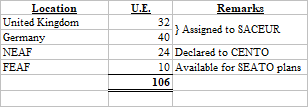23.
NATO. So far as the strength of the NATO-assigned TSR2 force is concerned, it must be appreciated that this force, plus the FGA/R aircraft also required, has effectively to replace 137 V-bombers, 88 Canberras, and 16 Hunters. In view both of the operational task and of the need to maintain influence in the Alliance, its is considered that at least 72 TSR2s must be assigned to SACEUR, in addition to the FGA/R aircraft considered in para. 43 below. As to the disposition of this force, the advent of the TSR2 introduces new possibilities of combining operational, organisational and economic advantages without losing tactical advantage or political influence. Hitherto it has been necessary to deploy on the Continent all those air forces assigned to Allied Command, Europe, with the exception of the V-Force and Fighter Command; this has been due to the nature (range etc.) of the available aircraft and the consequent need to base them forward for tactical and political reasons. Now, however, it is not only feasible but desirable to consider deployment of the Strike/Reconnaissance Force in the United Kingdom, for the following reasons:-
(a) Its long range and ubiquity makes it unnecessary to base it forward, at least permanently.
(b) By basing such aircraft in the United Kingdom instead of in Germany, their vulnerability to surprise attack (a matter of great concern to SACEUR) will be considerably reduced. Indeed, no attack by the Russians upon aircraft in the United Kingdom bases could possibly be construed as an act of "limited war", and this resultant immunity of the force in such conditions would in itself reduce still further the possibility of limited aggression in Central Europe.
(c) Deployment on the Home bases will ease the maintenance problems of a complex weapon system, as well as reducing considerably expenditure of foreign exchange.
(d) Full advantage can be taken of the complex of communications, bases, and dispersal airfields built up for Bomber Command.
(e) Political kudos could be gained by the obvious implication (already made by the assignment of Bomber and Fighter Commands) that the United Kingdom was very much part of the A.C.E. by the deployment of the assigned element in the United Kingdom (a tenable argument with such an aircraft). However, this would not obviate the need in any event for the deployment on the Continent of shorter range aircraft required to balance the ground forces there, and to provide "presence".


